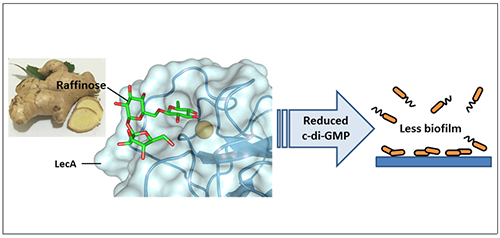Sweet flavor of ginger can serve as a natural ingredient that prevents tooth decay
Raffinose, a natural ingredient from ginger, can substitute synthetic biofilm substances
A research team led by Prof. Hee-Deung Park published its article in Scientific Reports, which is published by the Nature Publishing Group
Raffinose, with its sweet flavor, is derived from ginger, and is expected to be applied to foods, medicines, and in other related industries.

▲ (Left) Prof. Hee-Deung Park from the School of Civil, Environmental and Architectural Engineering, College of Engineering; (Right) Prof. Youngjoo Byun from the College of Pharmacy
The research team, led by Prof. Hee-Deung Park from the School of Civil, Environmental and Architectural Engineering in the College of Engineering, announced that it had screened a biofilm inhibitor, raffinose, derived from ginger.
* Biofilm: An assemblage of microorganisms that are encapsulated in extracellular polymeric substances. Biofilms formed on surfaces are notoriously difficult to eradicate.
* Raffinose: A trisaccharide composed of galactose, glucose, and fructose and is found in various plants
The research was conducted by a research team led by Prof. Hee-Deung Park from Korea University (joint research with Prof. Youngjoo Byun), funded by the Individual Basic Science & Engineering Research Program of the Ministry of Education. The findings were published in Scientific Reports on May 4th.
* Title of the Article: Raffinose, a plant galactoside, inhibits Pseudomonas aeruginosa biofilm formation via binding to LecA and decreasing cellular cyclic diguanylate levels
* Author Information: Han-Shin Kim (first author), Eunji Cha (co-author), YunHye Kim (co-author), Young Ho Jeon (co-author), Betty H. Olson (co-author), Youngjoo Byun (correspondence author), and Hee-Deung Park (correspondence author)
Biofilms are formed on various surfaces, such as teeth and water pipes, and cause various problems. Treatments with antibiotics are often ineffective in eradicating biofilms associated with bacterial infection.
To resolve such issues, food and pharmaceutical companies have been actively engaging in developing synthetic compounds inhibiting biofilm formation, but unlike synthetic biofilm inhibitors, natural products in biofilm inhibition have rarely been developed.
The research team confirmed that the ginger extract had the capability to reduce biofilm formation for various bacteria, including Pseudomonas aeruginosa, for the first time in the world in 2011. The team demonstrated that the biofilm inhibiting effects of raffinose were comparable to furanone C-30, a well-reported synthetic biofilm inhibitor, in this research.
* Pseudomonas aeruginosa: A common gram-negative rod-shaped bacterium that can cause disease in plants and animals, including humans. It is known to cause infections mainly in immunocompromised individuals at hospitals.
* The research team led by Prof. Hee-Deung Park (Korea University) published its findings that the ginger extract had the capability to reduce biofilm formation for various bacteria, including Pseudomonas aeruginosa, in 2013 and then 6-gingerol, a main ingredient of ginger, was effective in biofilm inhibition in 2015.
* Furanone C-30: One of the most representative biofilm inhibitors, generated by the research team led by Prof. Michael Givskov from the Technical University of Denmark. The synthetic furanone compounds were based on a natural biofilm inhibitor found in seaweed by changing its chemical structure.
The research team also proved that raffinose prevented the normal function of galactose, required for the biofilm formation of bacteria, thus inhibiting biofilm formation and decreasing the concentration of the second messenger, cellular cyclic diguanylate (c-di-GMP).
* Binding of raffinose to LecA: According to nuclear magnetic resonance (NMR)-binding experiments and molecular modeling, raffinose was binding to a carbohydrate-binding protein of bacteria, called LecA.
* Second messengers: Intracellular signaling molecules released by the cell in order to trigger physiological changes such as proliferation, differentiation, and the creation of toxic components.
* c-di-GMP: A second messenger with GMP, a nucleotide, combined in a loop shape and known to play an important role in the biofilm formation of bacteria
The research is the result of a joint study that created synergy by combining the quantitative approach of engineering (Prof. Hee-Deung Park) and the molecular analysis of pharmacy (Prof. Youngjoo Byun).
Prof. Park stressed the significance of the research saying, “Raffinose is derived from natural products and is applicable as a tooth-care product thanks to its sweet flavor. It can be easily extracted from not only ginger, but also various plants and is applicable to related industries due to its affordable price.”
* Application to related industries: The finding has applied for a domestic patent and a PCT global patent.
In addition, Prof. Byun said, “Prescribing Raffinose with existing antibiotics can increase the potency of the antibiotics and help effectively treat bacterial infections with a tolerance to antibiotics due to biofilm formation.”
* Potency: A measure on how much microorganisms (bacteria and fungus) are affected by certain antibiotics. It means the ability to inhibit the proliferation of microorganisms.
Terminology:
1. Scientific Reports
○ A globally renowned scientific journal published by the Nature Publishing Group. Its impact fact is 5.578.
2. Furanone C-30
○ The research team led by Prof. Michael Givskov from the Technical University of Denmark found a substance in seaweed that inhibited bacteria’s biofilm formation and synthetized Furanone C-30 by transforming its chemical structure in order to enhance its capacity.
3. Pseudomonas Aeruginosa
○ A common gram-negative rod-shaped bacterium that can cause disease in plants and animals, including humans. It is known to cause infections mainly in immunocompromised individuals at hospitals. It is the leading pathogen of chronic cystic fibrosis (CF) lung infection, forming biofilm making it difficult to treat with antibiotics.
4. Nuclear Magnetic Resonance
○ NMR is a method used to add energy with radio frequencies to materials with nuclear magnetic moment in order to analyze the resonance and interpret the structure of molecular compounds and protein-ligand interactions.
Figure Description:

▲ Figure 1: Mechanism in which raffinose, a plant galactoside, inhibits biofilm formation of bacteria
ㅇ Raffinose: A trisaccharide (green compounds in figure) composed of galactose, glucose, and fructose and is found in various plants, including ginger.
ㅇ Pseudomonas aeruginosa has a carbohydrate-binding protein, LecA (cloud-shaped structure in figure), which should be bound with a certain galactose in oder to form biofilm. The binding of raffinose to LecA interferes the binding of LecA to galactose.
ㅇ The binding of raffinose to LecA significantly decreases the concentration of the second messenger, c-di-GMP within the P. aeruginosa cell, thus inhibiting biofilm formation.



